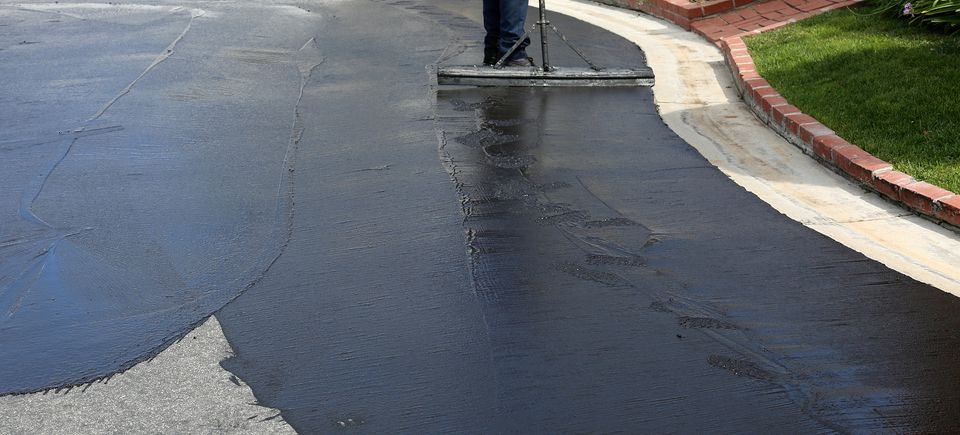Warm Mix Asphalt: A Lasting Remedy for Sidewalk
Warm Mix Asphalt (HMA) has arised as a leading sustainable selection for sidewalk options, using a myriad of environmental benefits and cutting-edge technologies. As the demand for environment-friendly building and construction practices expands, checking out the subtleties of HMA's sustainability can supply useful insights right into the future of sidewalk solutions.
Environmental Benefits of Warm Mix Asphalt

Additionally, Hot Mix Asphalt assists to minimize city heat island effects. Its dark color takes in sunlight, lowering the quantity of warm reflected back right into the environment contrasted to lighter-colored sidewalks. This can lower ambient temperature levels in city areas, decreasing the demand for cooling and inevitably minimizing power intake.
Furthermore, Warm Mix Asphalt contributes to improved stormwater administration. Its permeable nature permits water to reenergize and infiltrate the pavement groundwater materials, decreasing drainage and the risk of flooding. These ecological advantages make Hot Mix Asphalt a lasting choice for leading roads and highways.
Power Efficiency in HMA Manufacturing
Is power effectiveness an essential factor in the manufacturing of Warm Mix Asphalt (HMA)? Absolutely. Energy plays a substantial function in the manufacturing of HMA, affecting both expense and environmental sustainability. One vital aspect of energy efficiency in HMA manufacturing is the usage of cozy mix asphalt (WMA) innovations (hot mix asphalt). WMA permits for the mixing and placement of asphalt at reduced temperature levels compared to standard warm mix asphalt, causing decreased energy usage during production. This process not only lowers fuel use but likewise lowers greenhouse gas emissions, making it a more eco-friendly alternative.
Furthermore, developments in plant innovations have actually led to more energy-efficient HMA manufacturing procedures. Modern plants are made with attributes like recycled asphalt sidewalk (RAP) handling capacities, reliable burner systems, and enhanced insulation, all adding to power cost savings. By maximizing power usage in HMA production, the industry can lower its carbon footprint while keeping high-quality sidewalk products. Energy efficiency is, therefore, a critical consideration in ensuring the sustainability of Hot Mix Asphalt manufacturing.
Recyclability of Hot Mix Asphalt
The recyclability of Warm Mix Asphalt (HMA) is a pivotal facet of its sustainability and web long-term ecological effect. HMA is among one of the most recycled materials in the USA, with over 100 million lots of reclaimed asphalt pavement (RAP) being reused annually in brand-new pavement construction. Recycling HMA uses numerous ecological benefits, such as decreasing the need for virgin materials, decreasing energy intake throughout manufacturing, and reducing the quantity of waste sent to landfills.
The process of reusing HMA includes milling the existing sidewalk, squashing it right into smaller items, and blending it with new aggregate and asphalt binder to develop a recycled mix. On the whole, the recyclability of HMA plays a substantial function in advertising sustainable practices within the sidewalk industry.

Long-Term Efficiency of HMA
Asphalt sidewalks demonstrate sturdiness and resilience over a prolonged period, mirroring the lasting efficiency of Hot Mix Asphalt (HMA) In addition, advancements in HMA innovation, such as the usage of polymer-modified binders and warm visit this web-site mix asphalt, have actually even more boosted the toughness and longevity of HMA sidewalks. By prioritizing top quality building and construction and maintenance techniques, HMA continues to show itself as a economical and sustainable service for durable pavement framework.

HMA: Durability and Sustainability
Demonstrating both sturdiness and sustainability, Hot Mix Asphalt (HMA) has actually come to be a foundation in the building and construction of resilient sidewalk facilities - hot mix asphalt. HMA's longevity originates from its capacity to endure hefty lots, extreme climate conditions, and high web traffic quantities, making it a reliable choice for roads, freeways, and airport terminal runways. The structure of HMA, which generally consists of aggregates, binder, and filler, plays a critical function in enhancing its durability and resistance to tear and put on
Furthermore, HMA's sustainability hinges on its recyclability and energy-efficient manufacturing process. The capability to reuse recovered asphalt sidewalk (RAP) in new HMA mixes decreases the demand for virgin products and reduces the ecological impact of sidewalk construction and maintenance. Furthermore, the power efficiency of creating HMA hinges on its lower mixing temperatures contrasted to other sidewalk products, leading to minimized energy usage and greenhouse gas emissions.
Conclusion
To conclude, hot mix asphalt (HMA) offers a lasting remedy for sidewalk with its environmentally friendly characteristics. HMA's recyclability, power effectiveness in production, and long-lasting longevity make it a green choice for roadway construction. By preserving natural deposits, decreasing waste, and reducing greenhouse gas discharges, HMA plays an important duty in advertising sustainability in facilities development. Its capacity to alleviate urban heat island results even more underscores its value in developing resistant and eco mindful pavement systems.
HMA is one of the most recycled products in the United States, with over 100 million bunches of redeemed asphalt sidewalk (RAP) being reused each year in new sidewalk construction.The procedure of reusing HMA includes grating the existing pavement, crushing it into smaller sized items, and mixing it with published here new accumulation and asphalt binder to develop a recycled mix.Asphalt sidewalks show resilience and strength over an extended duration, reflecting the long-lasting performance of Hot Mix Asphalt (HMA) In addition, developments in HMA innovation, such as the usage of polymer-modified binders and warm mix asphalt, have additionally enhanced the longevity and long life of HMA sidewalks. The ability to reuse recovered asphalt sidewalk (RAP) in new HMA mixes lowers the demand for virgin products and lessens the ecological influence of sidewalk construction and upkeep.